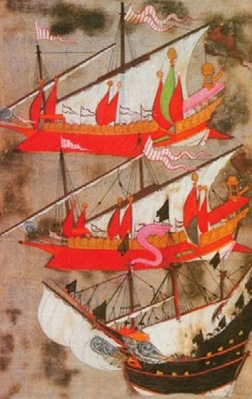Naval and river fleets
For an empire possessing large dominions in both Asia Minor and Europe it was essential to secure the continuity of communication and transfer of forces between the two continents. This could not be achieved without effective control of the Straits, a task which, in turn, could not be fulfilled without a naval fleet, especially as long as Byzantium existed in the heart of the empire.
However, lacking any seafaring experience, the Ottomans were forced to turn for help to various Turkish forces who practised piracy on the Aegean. A Venetian report suggests that they had a smaller fleet of their own as early as 1374. After the conquest of the maritime principalities of Aydýn and Menteşe several skilled men and experts came into Ottoman service, giving a great impetus to the development of the navy. The Ottomans also used and integrated Byzantino-Greek traditions and manpower, just as they were ready to learn from, and accept the help of, the Latins, especially the Genoese, in the Levant. It was the Genoese who undertook several times to ship the Ottoman troops across the sea. In shipbuilding and dockyard technology, they were most strongly influenced by the Venetians. This openness and multi-directional acculturation is reflected by the Ottoman nautical vocabulary which abounds in Greek and Latin/Italian words.
During Bayezid I’s reign, the Ottoman fleet had a mere seventeen vessels, whereas around 1402 a traveller reported forty to sixty ships. The first marine base and main crossing point of the Ottomans was Gelibolu (Gallipoli), earlier the centre of the Byzantine fleet. The Byzantine historiographer Doukas recorded that Sultan Bayezid had it considerably rebuilt and fortified with towers to make it suitable for shipbuilding and the accommodation of large galleys, and to enable its naval forces to control the commercial traffic through the Straits and to levy duties on it. The harbour consisted of an outer and an inner pool separated by a bridge fortified by a three-storey tower. The mouth of the harbour was closed by a chain in case of necessity. By 1422, further fortifications (walls and towers) had been built, necessitated by the enemy attacks of the previous years.
The Gelibolu base had irritated the Venetians from the beginning, since they were worried that the strengthening Ottoman naval forces would threaten the freedom of their trade. The first open sea battle between the two powers took place on 29 May 1416, after the Ottoman fleet, consisting of thirty vessels and led by Admiral Çali, had plundered the Venetian islands. The Venetians scored a crushing victory, seizing twelve, fourteen or twenty-seven ships, according to different sources. In the course of the Venetian–Ottoman war of 1423–30 the Venetians broke into the inner harbour of Gelibolu but in the end failed to keep the docks.
By the middle of the century the size of the Ottoman fleet, which consisted mainly of oared galleys with single masts and lateen sails (kadirga), had increased considerably. According to a Venetian eye-witness account, the Ottoman fleet blockading Constantinople in 1453 comprised 145 ships: 12 galleys, 70 to 80 large galiots (fusta/kalyata), 20 to 25 parandaria and other ships, including pirate vessels. In addition to the warships, the Ottomans probably from an early date used larger ships for transporting men, horses, ammunition and, later, ordnance. The fleet admiral’s post was probably filled by the district governor of Gelibolu, although the first evidence to verify this assumption dates from 1453.
The Ottoman fleet was for a long period deployed around the Straits, its activity being restricted to covering the crossings, as well as attacking enemy ships and shores. In the late 1420s, it ventured into the Aegean and, in support of the land troops, took part in combined attacks, for example in the sieges of Thessalonike (1430) and Constantinople (1453). The role of the navy in both cases was to complete the blockade of the city on the side facing the sea and deprive the defenders of the possibility of obtaining external help. Although it was a great step forward, the Ottoman warships were still far from standing their ground in an open formal battle with the more heavily built, better equipped western fleets. The fact, however, that apart from the Venetians and the Knights Hospitaller of Rhodes, only the Ottomans had a regular navy, considerably increased the political weight of their state.
When the Ottomans reached the Danube and encountered the Hungarian ships laden with artillery, they quickly recognised the importance of river fleets. Apparently, they already had river forces on the Danube and on the Morava in Serbia during Murad II’s reign. Hungarian sources inform us that when King Sigismund laid siege to the fortress of Galambóc (Golubac, Güğercinlik) on the Danube in 1428, the Ottomans tried unsuccessfully to break through the Hungarian blockade with ships sent up the Morava. In 1433, Bertrandon de la Broquière noted that the sultan kept eighty to a hundred fustas (galiots, small oared warships) at the confluence of the Serbian rivers, the western and southern Morava, for the crossing of horses and troops, and that the ships were guarded by 300 men, replaced every two months. He found another hundred fustas at Galambóc, also used to transport soldiers across to Hungary. It has been suggested that the Ottomans may have used some sort of ordnance aboard these ships because their Hungarian counterparts were also equipped with small cannons. On the basis of this information and these suggestions, it can be concluded that river flotillas must have been employed for the transport of troops and animals as well as for the siege of riverside fortresses in a variety of ways: taking troops to the shore, blockading a fortress and shooting at the fortress wall from the cannons aboard.
